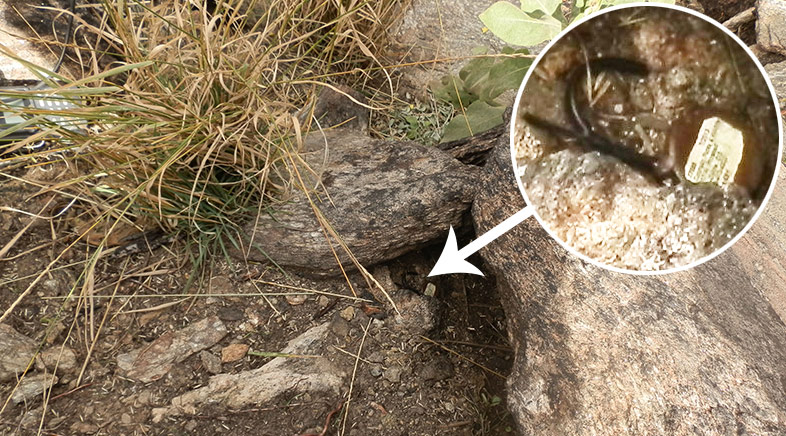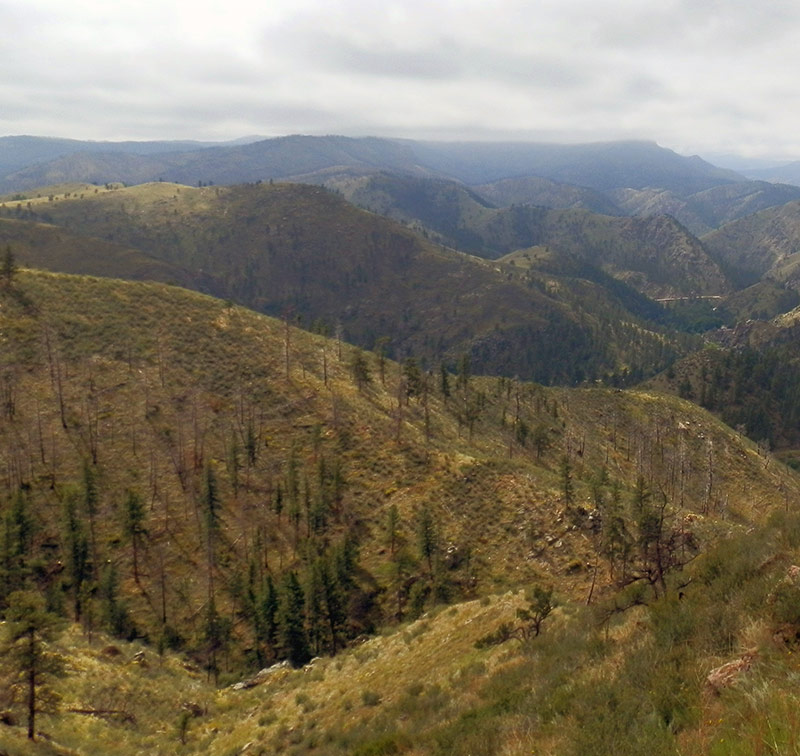 Utah chukar released in Colorado have now been in the field between 6 and 6 ½ months, depending on release group. Of the original 168 birds, we have flushed coveys which we've located using telemetered birds and have seen a visual minimum of 58 birds in 6 coveys by the end of February. We have at least one more covey with a radio collar in it that we haven't been able to precisely locate due to a month+ of weather canceled fixed wing flights. There are also very likely coveys in the field without radio collars in them, so 58/168 should be considered an absolute minimum on chukars alive in the field in late February. Based on the large portion of the original release that is known to be alive based on being counted as part of a flush count, transplanted bird survival is higher than expected. However, chukar survival through winter into pairing and nesting are still big milestones that will need to be achieved.
Utah chukar released in Colorado have now been in the field between 6 and 6 ½ months, depending on release group. Of the original 168 birds, we have flushed coveys which we've located using telemetered birds and have seen a visual minimum of 58 birds in 6 coveys by the end of February. We have at least one more covey with a radio collar in it that we haven't been able to precisely locate due to a month+ of weather canceled fixed wing flights. There are also very likely coveys in the field without radio collars in them, so 58/168 should be considered an absolute minimum on chukars alive in the field in late February. Based on the large portion of the original release that is known to be alive based on being counted as part of a flush count, transplanted bird survival is higher than expected. However, chukar survival through winter into pairing and nesting are still big milestones that will need to be achieved.
| MINIMUM CHUKAR IN COVEYS WITH AT LEAST ONE RADIOED BIRD |
| Flush Round | Date | Number Flushed |
| 1 | 12/9/2014 | 14 |
| 1 | 12/8/2014 | 1 |
| 1 | 12/22/2014 | 11 |
| 1 | 12/23/2014 | 9 |
| 1 | 1/5/2015 | 6 |
| 1 | 12/31/2014 | 13 |
| TOTAL | | 54 total birds |
| 2 | 1/22/2015 | 10 |
| 2 | 1/27/2015 | 15 |
| 2 | 1/27/2015 | 11 |
| 2 | 1/29/2015 | 12 |
| 2 | 2/2/2015 | 15 |
| 2 | 1/30/2015 | 6 |
| TOTAL | | 69 total birds + unflushed another covey |
| 3 | 1/9/2015 | 7 |
| 3 | 2/16/2015 | 7 |
| 3 | 2/16/2015 | 12 |
| 3 | 2/17/2015 | 13 |
| 3 | 2/18/2015 | 3 |
| 3 | 2/19/2015 | 16 |
| TOTAL | | 58 total birds |
Field Report 4 - 1/12/2015
Searching for Collars
The CPW Poudre Canyon chukar project has now had birds surviving for 5 months in northern Larimer County. As of mid-January there are 23 collars out of 60 still in the field. Unfortunately, about a third of those haven’t been located on a regular basis and may well be mortalities that just haven’t been detected yet due to the challenges of monitoring signals in the rough country of the Poudre Canyon. If all 23 were assumed alive, this would produce a 5-month survival rate of 23/60= 38%. The increased survival rate of adults has slowly started to emerge, relative to the large number of juvenile birds we received from Utah. At release 37% (22 of 60) of the radioed birds were adults, but 5 months later 44% (10 of 23) of the surviving birds are adults. This is expected as adult chukar have roughly a 4-fold higher survival rate than juveniles.
I have started flush counts to locate collared chukar and attempt to flush the bird to see if it is alone or accompanied by uncollared chukar. To date, nearly all collared birds are in large coveys of uncollared birds. This is a positive in terms of surviving through the cold and snow of winter. The next biologist field note update will provide more documentation on coveys and flush counts.
Field Report 3 - 11/28/2014
 Photo 1: Collar located in pack rat cache
Photo 1: Collar located in pack rat cache
Chukar released in the lower Poudre have now been in their new habitat for over 3 months. Of the 60 radio collared birds that were originally released, 32 have been recovered as mortalities or dropped collars. Therefore, a rough 3 ½ month survival rate on the collared sample is about 47% (28/60). Compared to documented survival in wild non-transplanted populations, this survival rate would not be considered low. Particularly since the large majority of Poudre transplanted birds were juveniles (who have lower natural survival than adults). Since pack rat caching has been observed in the majority of mortalities, cause of death continues to be relatively hard to assess.
 In terms of broadcasting their frequency signal over long distances, the radio collars on Poudre chukar are fairly weak. Topographic features like canyons, cliffs, hillsides and large rocks can partially block the radio signal from the biologists monitoring the collars. With radioed chukar spread over an area as large as 90 sq miles, it has been challenging to make even weekly radio contact with all collared birds. In some cases roads allow an observer to quickly access and scan for radio frequencies. However, several birds are using large roadless areas, where radio frequencies can’t easily be heard without making longer hikes. Chukar also seek out steep canyons, rocky hillsides and cliff edges, which in some cases require a biologist to get within 300-400 yards of the radioed bird’s location in order to hear it.
In terms of broadcasting their frequency signal over long distances, the radio collars on Poudre chukar are fairly weak. Topographic features like canyons, cliffs, hillsides and large rocks can partially block the radio signal from the biologists monitoring the collars. With radioed chukar spread over an area as large as 90 sq miles, it has been challenging to make even weekly radio contact with all collared birds. In some cases roads allow an observer to quickly access and scan for radio frequencies. However, several birds are using large roadless areas, where radio frequencies can’t easily be heard without making longer hikes. Chukar also seek out steep canyons, rocky hillsides and cliff edges, which in some cases require a biologist to get within 300-400 yards of the radioed bird’s location in order to hear it.
One way CPW biologists can overcome some of these challenges is to employ the use of fixed-wing aircraft. We have conducted three different flights to locate missing birds, pinpoint mortality locations, and quickly survey large areas. The use of aircraft as a tool has helped significantly in keeping track of these released birds, and has largely been responsible for detecting some of the chukar long-range movements we’ve identified since release. One single radio moved from the lower Poudre Canyon into the Buckhorn Canyon, before returning to the Poudre. The straight-line distance from release site to where it was found from the plane was over 9 miles. A number of radioed chukar have also moved out of the lower Poudre release sites and are currently using steep, rocky habitat about 7 miles northwest of their September locations. In one case, 5 radioed birds, along with a number of uncollared birds have been located together for the last 4 weeks and their movements appear to be localizing. By staying in one area, becoming familiar with the habitat and cover, these birds will hopefully have a better chance of survival than those that continue to move large distances into unfamiliar habitat.
Field Report 2 - 11/5/2014
Chukar released in the lower Poudre from the three mid to late August releases have now been in their new habitat for 10-11 weeks. Of the 60 radio collared birds that were originally released, 19 have been recovered as mortalities or dropped collars. Therefore, a rough 2 ½ month survival rate on the collared sample is about 68% (41/60). Biologists expect mortality to be highest in the months immediately following a transplant as birds adjust to new habitat, predators and weather patterns, as well as overcoming the initial stress of capture and transport. As a point of reference, annual (12 months) adult survival in Utah has measured in the range of around 15%, so even under the best circumstances only about 9 of the 60 chukar collared in the Poudre would be expected to persist a full year. Poudre chukar causes of mortality have been relatively hard to determine based on the difficulty in getting to dead birds within a day or two of the collar switching to mortality pulse.

Photo 1: Collar located in woodrat middens
In the vast majority of cases where a chukar has died and the collar switches to mortality, woodrats have located the collar and moved it to their middens before CPW field technicians can locate the mortality (Photo 1). This caching behavior by woodrats moves the collar from the location where the bird died, and even with search attempts in the area around the woodrat midden, locating evidence of the chukar carcass has been met with little success. All collars that have been located still attached or associated to the dead bird, have all indicated avian predation as the cause of mortality. In one case, the raptor plucked the bird, ate every bit of meat and bone, but left the chukar’s red beak along with a feather pile as the only remaining piece of evidence (Photo 2). Unfortunately, one uncollared but legbanded chukar was also illegally harvested in the temporary chukar hunting unit closure.

Photo 2: Chukar’s red beak and feathers
Some radio collared chukar have moved fairly long distances. In one case a bird is now being located about 11 airmiles west of the release location. Some of these movements have made monitoring radio collared birds more challenging, but the next Biologist Field notes will focus on some of the movements and habitat use that has been observed.
Field Report 1 - 10/6/2014

